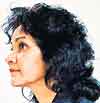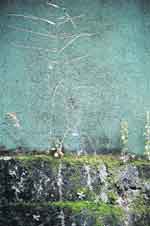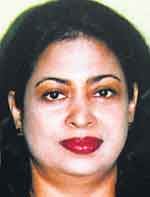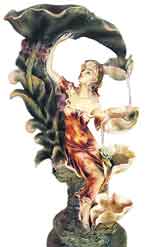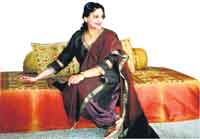|
|
|||||||||||
|
Come, enter and share this visual poem Seneka Abeyratne reviews Anoma Wijewardene’s bold experiment with digital art
Anoma Wijewardene is at the cutting edge of modern art in Sri Lanka. Her works, especially her mixed media paintings, embrace a wide range of spiritual and cross-cultural themes bordering on mysticism, which perhaps are only accessible to the connoisseur of art. Yet even the layman cannot fail to notice certain aspects of her compositions, such as the complex spatial configurations, the dense, multi-layered textures and solid, rocklike masses arranged in a sequence of planes, the vibrant colours and dynamic forces and the sense of motion conveyed through rhythmic strokes of the brush and the palette knife. Many of her paintings, including a recent series inspired by Rilke’s poems, are attempts at integrating fragments of diverse culture and ideas as well as interweaving iconic and personal idioms, lines and motifs through powerful, abstract imagery. Even though her works entail a high level of spiritual and metaphysical apprehension, they are grounded in reality, and it is this intriguing blend of realism and mysticism that gives each and every one of her paintings a rare, luminous quality. Anoma’s distinctive trademarks are her profoundly aesthetic treatment of cross-cultural themes, her heartfelt lyricism, and her own transcendental technique, which few other eastern artists can match. Anoma, a graduate of Central St. Martins College of Art, London, lived for many years in the west before settling down in Sri Lanka in the late 1990s. Before returning to her native land, she was a visiting lecturer for over ten years at several British Art Colleges. Prior to becoming an artist she was a successful designer in Europe, having published her works in such prestigious magazines as British Vogue, HarpersUK, The Times London, and Architectural Digest USA. Her clients included Pierre Cardin, Yves St Laurent, Calvin Klein, and Ralph Lauren.
Her career as a professional artist has taken her on a more creative and illustrious path. During the past decade, her works have been exhibited in several cities, including Colombo, Singapore, Kuala Lumpur, New Delhi and Brisbane. Her most recent solo exhibition in Sydney (2005) received glowing reviews in the Australian press. Some of her best paintings are now in private collections in North America, Europe and Asia. Anoma’s new project, entitled “Quest”, represents a qualitatively new phase in her artistic career – a quantum jump, so to speak – as it involves a bold experiment with interactive digital art. At the trilingual, multimedia exhibition we see her first outcrop of digital images, which have been composed over the past three years using computer technology. The exhibition, which combines digital art with interactive video installations to probe the social and cultural landscape of Sri Lanka, brings the audience face to face with two central overlapping themes, namely ethnic conflict and tsunami destruction. Anoma has experimented with a wide range of artistic styles including realism, expressionism, impressionism, surrealism and cubism so as to stir the imagination and empower the viewer to comprehend the full import of the conflict and the tsunami disaster. The timing could not have been better as the country is once more on the brink of civil war. The paintings, which could be viewed as a photo essay or a visual poem, are superbly composed and leave a lasting impression on the viewer. Through stark juxtapositions and powerful imagery, the artist compels us to subject her works to close scrutiny and to dwell on their weighty social and political subtext. Anoma’s intention is not to provide answers but rather to sensitize the viewer to the issues and challenges confronting this conflict-ridden nation. For example, the haunting images of poverty-stricken refugees raise many questions: Are they conflict IDPs or tsunami IDPs or both? How long will they remain refugees? What is their destiny? Does anyone care? The exhibition’s audio visual component
consists of a synchronized, multi-screen, power-point/DVD presentation
with new-age, electronic music provided by a talented young Sri
Lankan composer. The objective of this exercise is to enhance and
intensify the artistic impact of the images through an interactive
communication process. Says Anoma: “The multi-screen video
installation vastly increases the possibility of fusion and layering,
overlapping and repeating in several ways to allude and hint at
a myriad of possibilities, interpretations and realities. The integration
of different elements – imagery, sound, movement, an idea
installed in a sculptural environment – In sum, this is the most ambitious and visionary project undertaken by Anoma to date, which exploits the interface between digital art and modern communication technology so as to create a “visual poem for viewers to enter and share”. Viewed in this context, the interactive art exhibition (the first of its kind) represents a personal milestone, a ground-breaking achievement, which is likely to add a new chapter to the history of artistic expression in Sri Lanka.
A gallery of beauty
“I like dealing with beautiful things,” says Manique Gunawardena reflectively, surveying her collection of artworks. She sits on a bench and all around her the rare and exquisite are arranged – all of which are for sale at a price. Her gallery on Bullers Road ‘Objects d’ Art’ has been in Mrs. Gunawardena’s family for over 50 years now and she has personally been in charge of it for the last two decades.
For Mrs. Gunawardena, her small enterprise combines her passion for art with her love of travel. Having seen much of Europe and Asia, her collection at Objects d’ Art is as eclectic as it is intriguing. Pieces of European statuary are to be found side by side with Chinese pagodas and Kandyan artefacts. In the displays, genuine antiques mingle freely with exact replicas and therefore while some pieces are ancient and elegant, others are modern and innovative. Diverse styles and techniques find representation - paintings, furniture, lamps, statuary, jewellery, and other knick knacks all fill the space. Mrs. Gunawardena is particularly proud of her collection of what she calls feng shui pieces. Mostly Chinese in origin, these artefacts are said to be lucky and beneficial to the atmosphere of a house. She points out a Chinese pagoda - one of her prime feng shui pieces. Traditionally a pagoda is an auspicious symbol associated with protection and education. All considered, her collection remains small, each piece hand picked by her for its unique appeal. “I have only about 50 pieces (excluding the jewellery) in my inventory at any given point in time,” she reveals.
Some pieces are particularly striking. Take for instance, the Indonesian wrought iron mini bar which she says it’s unlikely she will ever agree to part with or the huge wooden Dutch chest which is over 200 years old. The statues featuring everything from nubile young goddesses, roaring lions, large fish and knights astride their horses are particularly noteworthy. Cast in bronze for most part, these solid pieces are detailed and well executed. Interestingly, a majority of the work is commissioned from local artisans – some of whom are based in Kandy. Mrs. Gunawardena explains that she commissions pieces regularly from them. Some are of her own designs, while many others are replicas of creations she has only seen pictures of. Her arrangements with carpenters, sculptors and other artisans also make it possible for her to custom make artefacts for clients. Objects d’ Art was first begun by Mrs. Gunawardena’s father, Mr. Dharmapala, who was an engineer by profession at Radio Ceylon. “After retirement he devoted his time and energy to his great love – the collecting of antiques,” revealed Mrs. Gunawardena, adding, “he was the pioneer of the business that is now shared by my brothers and I.” Despite its long history, the operations of the gallery remain curiously informal. The gallery is part of Mrs. Gunawardena’s home and the art works are scattered all over the place - overflowing into the garden, into the garage and then into the very house itself. Objects d’Art has the appeal of a large treasure chest, an impression that is further heightened by its exclusivity. Mrs. Gunawardena receives clients by appointment only. An interior designer by profession, she explains that she also is involved in charity work that takes up much of her time. In fact, much of the proceeds from sales are re-directed to such worthy causes, she reveals.
The dance has just begun Tara Coomaraswamy traces the steps of Anandavalli, a Lankan Bharatha Natyam exponent, now domiciled in Australia The legendary dancer Ram Gopal described her as a “young dance phenomenon”. Professor P. Sambamoorthy, one of the highest authorities on Indian music and dance, said she had been “born with bells on her feet”. She had her Arangetram at the age of just nine, and by the time she was twelve had danced in Paris, and toured Germany and the UK. Although it is a few years since Anandavalli has performed in Sri Lanka, many in her native country will remember seeing her dance. Now settled in Sydney, she has forged a new career as a choreographer and artistic director and is making a significant contribution to the arts in Australia. Anandavalli was a child prodigy, whose talent was spotted early by her mother, Linga Satchitananda, daughter of the redoubtable Professor C. Suntheralingam, polymath and politician. Anandavalli began dance training at the age of seven under Neela Satyalingam. She was soon travelling regularly to Madras where she trained in Bharatha Natyam and Kuchipudi under such eminent gurus as Adyar K.Lakshmanan, Vazhuvor Ramaiya Pillai, Vempati Chinna Satyam, Vazhuvor R.Samarraj and Udupi Laxminarayan. After living and performing abroad for many years, and despite being offered British citizenship in 1974, Anandavalli returned to Sri Lanka to live, but after the traumatic events of July 1983, she and her family left to settle in Australia. She continued her international career as a dancer, performing in a range of countries, from Singapore and the Philippines to India, Pakistan and the UK. She has performed in all the major cities of Australia, including at prestigious venues such as the Seymour Centre and the Sydney Opera House. At the end of a successful national tour in 1989, she was honoured on stage after her Sydney performance by being awarded Australian citizenship in recognition of services to the arts in Australia.
She took her first two pupils in 1985 and today the Lingalayam Dance Academy (named after her mother) has nearly 100 pupils, who take part in sold-out annual productions. Anandavalli is proud of the fact that no fewer than twelve of her pupils have committed themselves to the years of arduous training required to undertake an Arangetram, or solo dance debut. In 1996 she also formed the Lingalayam Dance Company (LDC) around a core of graduates from her dance academy – mainly Sri Lankans and Indians but also, remarkably, some Australians. The LDC has put on a series of exciting and innovative productions and in under ten years has established itself as one of the major ethnic dance companies in Australia, with support from the New South Wales Ministry for the Arts. In 2002 the Dance Board of the Australian Council for the Arts awarded Anandavalli a Fellowship (granted only once in an artiste’s lifetime) to undertake advanced research into dance. In India, in addition to deepening her choreographic skills, she trained in a new Kuchipudi repertoire, had formal training in Carnatic music and also researched ancient scripts, music and the Indian epics. Back in Australia, she undertook an apprenticeship under one of Australia’s foremost experts in lighting design. Despite hanging up her shoes - or “bells”! - in December 2003, Anandavalli has been reborn as a choreographer-cum-artistic director. The majority of Dance Academy and Company productions are her creations. Interestingly, most of the LDC productions since 1999 have dealt with feminist themes. Anandavalli has taken traditional Hindu mythological stories and either developed hitherto unexplored aspects of them, or re-interpreted them for contemporary audiences so that their force as allegories of the human – particularly female – condition becomes more poignant. The LDC’s fascinating dance-dramas include “The Temple Dancer” and “The Courtesan’s Daughter” – which tell of how female dancers in the temple, all originally “brides of Siva”, Lord of the Dance, traditionally evolved into entertainers through royal patronage. “Serpent Woman” is the story of a woman who, in her desperation to have children, mates with a serpent – with horrific consequences for the twin girls she bears. “Earth and Fire” contrasts the heroines of the Ramayana and Mahabharata, showing how the patience and humility of a Sita can be as powerful, in their own way, as the fiery vengefulness of a Draupadi. A favourite of Anandavalli’s is “Sthree,” which describes the seven ages of Woman, from infancy, through to old age and “liberation” from the eternal cycle of life. The goal has been to demonstrate, through these diverse stories, women’s “shakthi” – their tremendous strength and ability to cope with life’s vicissitudes. Anandavalli herself seems the embodiment of Shakthi, with her tremendous drive and resourcefulness. Thoroughly professional, she demands the highest standards of herself as well as of the people she deals with. Although still relatively young, she is very much a “grande dame”, with the bearing and easy confidence of one who has been in the public eye for over 35 years. Always immaculate and beautifully dressed, she commands attention wherever she goes, not only because of her striking looks but also through the dynamism of her warm and lively personality. Madras, where I met her recently, is her second
home, after Sydney. She has a long association with the city, and
recalls how as a little girl, she used to be taken there three times
a year during school holidays, to study with her dance gurus, often
sleeping on mats on the floor in their houses. Now she lives in
the comfortable flat which her mother had bought in 1984, foreseeing
that her daughter would need this base from which to periodically
refresh and renew her creative wellsprings. And every year Anandavalli
returns, to consult her gurus, get new ideas and, more practically,
to get costumes sewn for her productions. Her son (appropriately named “Shakthidharan”) is carrying on the tradition. A high achiever academically, he decided against the conventional professional careers which were open to him, and chose to follow his passion for drama and music. He has had a significant input into Anandavalli’s work but has also recently set up a small theatre company of his own, called “Curious Works”. Its first major production was “The Migrant Project” which dramatised the experiences of immigrants from diverse backgrounds in Australia’s most cosmopolitan city, Sydney. What’s next? Life has never been busier. The LDC’s latest production, “Tarangini” had an audience of a thousand and raised $10,000 for children orphaned by the tsunami in Sri Lanka and for a women’s charity in India. Requests for the Company to dance at various events and venues are coming in thick and fast. There are plans to tour, possibly to Singapore or the UK. 2006 will see three more new productions – two by the Company and one by the Academy. Anandavalli is brimming with ideas, eager to take her Company in new directions and to evolve new forms through collaboration with other dance genres - though she is wary of that overworked word “fusion”. In 2004, for example, the LDC staged a revolutionary version of Shakespeare’s “Tempest”, with the collaboration of internationally renowned dancer-choreographer Astad Deboo, a veteran of many Indian and Western dance styles, Albert David, a specialist in Contemporary and Aboriginal Dance, and Prasanna, a guitarist whose range spans Jazz, Western Classical, Carnatic and World Music. One gets the feeling that Anandavalli has only
just begun. Although she already has an impressive list of achievements,
she is certainly not resting on her laurels. We can expect to hear
more of her in the future. Sri Lanka’s loss has definitely
been Australia’s gain. |
|||||||||||
Copyright © 2006 Wijeya Newspapers
Ltd. All rights reserved. |
